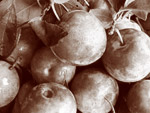 The American Plum is reddish, yellowish or sometimes an orange blend of both. The sub-varieties differ in season, size, shape, and flavor. The most common subspecies are round-oval shaped, and all have a thick skin, a sweet flesh and a clinging, oblong, and large stone.
The American Plum is reddish, yellowish or sometimes an orange blend of both. The sub-varieties differ in season, size, shape, and flavor. The most common subspecies are round-oval shaped, and all have a thick skin, a sweet flesh and a clinging, oblong, and large stone.
This native fruit spans from Maine to Florida in the east, northward from Mexico along the eastern slope of the Rocky Mountains in the west, and is also found in the Great Lakes region. Wild plums generally grow along roadsides and riverbanks, and at woodland and farmland borders. As urban sprawl increasingly threatens these areas, the wild plum is put at risk. In the 19th century it was documented that the American plum produced fruit annually, but in the 21st century the trees are producing fruit every other year.
Records of the wild plum date back to the 17th century. In Oregon, the local Indian tribes gathered the ripe fruit and dried it for winter and to garnish their wild fowl and game. The Dakota Indians made pudding out of the wild plums. They would serve this special dessert only during naming ceremonies and other important events. The Dakota Indians developed small orchards that they would move to at the end of summer. It was also believed that the bark, leaves, and flowers had medicinal properties.
American Plums are not commercially sold, but you may find them at local farmers markets when they are in season or find a wild tree of your own. The fruit is commonly used in jellies, jams, spreads and sauces for wild game.
http://www.slowfoodusa.org

